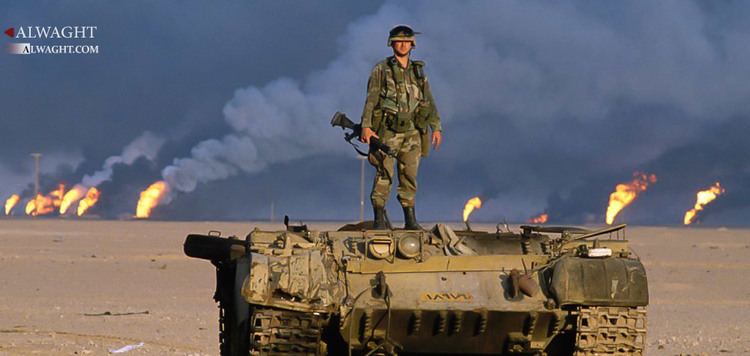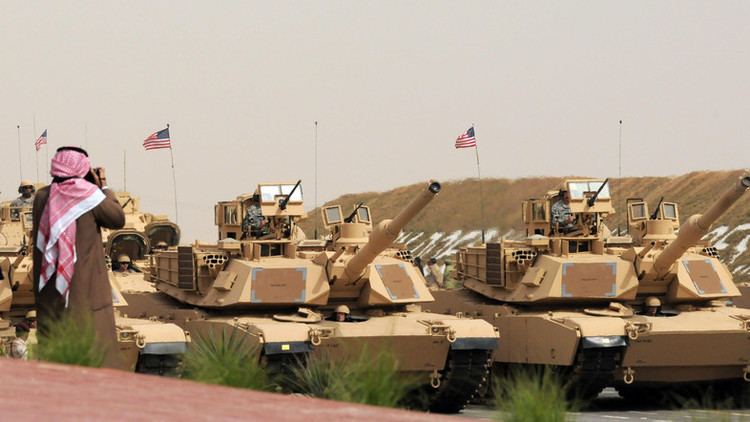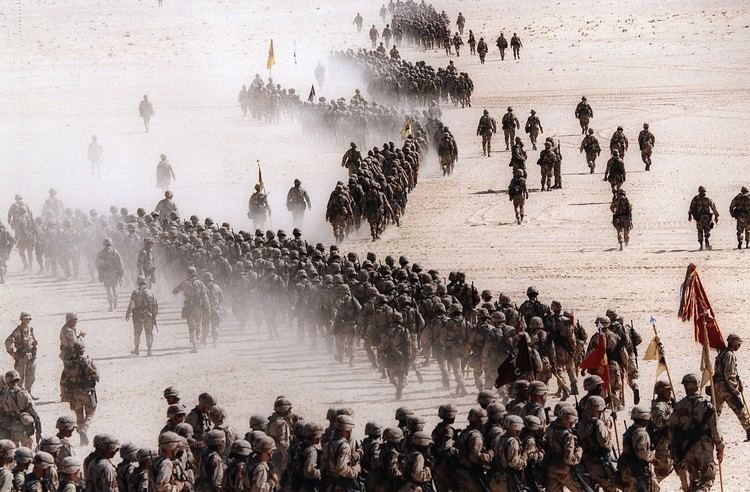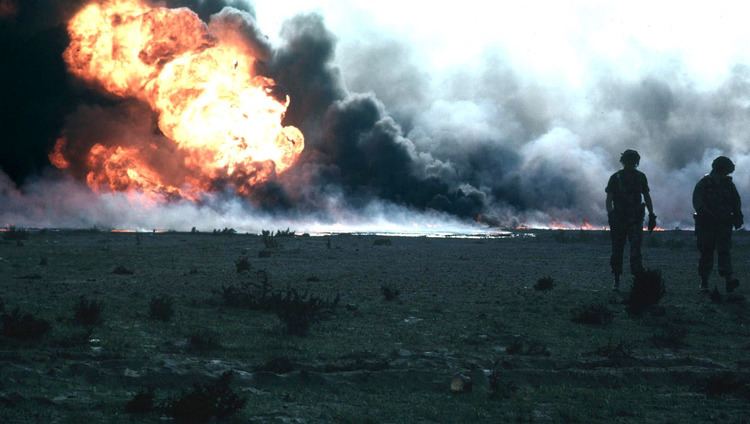Dates 2 Aug 1990 – 4 Aug 1990 Combatants Kuwait, Iraq | Location Kuwait | |
 | ||
88,000 Kuwaiti Army 20,000
Kuwaiti Air Force 2,200
Kuwaiti Navy 4,800
Kuwait National Guard
Kuwait Police
US contractors 95 aircraft destroyed (est.).
7,295 killed, 9,361 wounded
≈317 tanks and other armored vehicles
21 ships sunk 57 aircraft lost,
At least 8 aircraft captured (Mirage F1s)
4,200 killed,
12,000 captured
≈200 tanks destroyed/captured
850+ other armored vehicles destroyed/captured
17 ships sunk, 6 captured Results Iraqi-backed puppet state installed (Iraqi victory), Start of the Gulf War (Iraqi victory) Similar Gulf War, 2003 invasion of Iraq, Iraq War, Iran–Iraq War, Liberation of Kuwait campaign | ||
Invasion of kuwait explained
The Invasion of Kuwait, also known as the Iraq–Kuwait War, was a major conflict between Ba'athist Iraq and the State of Kuwait, which resulted in the seven-month-long Iraqi occupation of Kuwait, and subsequently led to direct military intervention by US-led forces in the Gulf War and the setting alight by Iraq of 600 Kuwaiti oil wells.
Contents
- Invasion of kuwait explained
- Invasion of kuwait
- Dispute over the financial debt
- Alleged economic warfare and slant drilling
- Iraqi hegemonic claims
- IraqiAmerican relations
- Invasion
- Kuwaiti resistance movement
- Aftermath
- International condemnation and Gulf War
- Post Gulf War
- References

In 1990 Iraq accused Kuwait of stealing Iraqi petroleum through slant drilling, although some Iraqi sources indicated Saddam Hussein's decision to attack Kuwait was made a few months before the actual invasion. Some feel there were several reasons for the Iraqi move, including Iraq's inability to pay more than US$14 billion that had been borrowed to finance the Iran–Iraq war, and Kuwaiti production of a large amount of petroleum which kept revenues down for Iraq. The invasion started on 2 August 1990, and within two days of intense combat, most of the Kuwait Armed Forces were either overrun by the Iraqi Republican Guard or fell back to neighboring Saudi Arabia and Bahrain. The State of Kuwait was annexed, and Saddam Hussein announced a few days later that it was the 19th province of Iraq.

Invasion of kuwait
Dispute over the financial debt

When the Iran-Iraq War broke out, Kuwait initially stayed neutral and also tried mediating between Iran and Iraq. In 1982, Kuwait along with other Arab states of the Persian Gulf supported Iraq in order to curb Iranian Revolutionary government. In 1982–1983, Kuwait began sending significant financial aid to Iraq. Kuwait's large-scale economic assistance to Iraq often triggered hostile Iranian actions against Kuwait. Iran repeatedly targeted Kuwaiti oil tankers in 1984 and fired weapons at Kuwaiti security personnel stationed on Bubiyan island in 1988. During the Iran–Iraq War, Kuwait functioned as Iraq's major port once Basra was shut down by the fighting. However, after the war ended, the friendly relations between the two neighbouring Arab countries turned sour for several economic and diplomatic reasons that culminated in an Iraqi invasion of Kuwait.

By the time the Iran–Iraq War ended, Iraq was not in a financial position to repay the US$14 billion it borrowed from Kuwait to finance its war and requested that Kuwait forgive the debt. Iraq argued that the war had prevented the rise of Iranian hegemony in Kuwait. However, Kuwait's reluctance to pardon the debt created strains in the relationship between the two countries. During late 1989, several official meetings were held between the Kuwaiti and Iraqi leaders but they were unable to break the deadlock between the two.
Alleged economic warfare and slant drilling

In 1988 Iraq's Oil Minister, Issam al-Chalabi, stressed a further reduction in the crude oil production quota of Organization of the Petroleum Exporting Countries (OPEC) members so as to end the 1980s oil glut. Chalabi argued that higher oil prices would help Iraq increase its revenues and pay back its US$60 billion debt. However, given its large downstream petroleum industry, Kuwait was less concerned about the prices of crude oil and in 1989, Kuwait requested OPEC to increase the country's total oil production ceiling by 50% to 1.35 million bpd. Throughout much of the 1980s, Kuwait's oil production was considerably above its mandatory OPEC quota and this had prevented a further increase in crude oil prices. A lack of consensus among OPEC members undermined Iraq's efforts to end the oil glut and consequently prevented the recovery of its war-crippled economy. According to former Iraqi Foreign Minister Tariq Aziz, "every US$1 drop in the price of a barrel of oil caused a US$1 billion drop in Iraq's annual revenues triggering an acute financial crisis in Baghdad". It was estimated that between 1985 and 1989, Iraq lost US$14 billion a year due to Kuwait's oil price strategy. Kuwait's refusal to decrease its oil production was viewed by Iraq as an act of aggression against it.

The increasingly tense relations between Iraq and Kuwait were further aggravated when Iraq alleged that Kuwait was slant-drilling across the international border into Iraq's Rumaila field. The dispute over Rumaila field started in 1960 when an Arab League declaration marked the Iraq–Kuwait border 2 miles north of the southernmost tip of the Rumaila field. During the Iran–Iraq War, Iraqi oil drilling operations in Rumaila declined while Kuwait's operations increased. In 1989, Iraq accused Kuwait of using "advanced drilling techniques" to exploit oil from its share of the Rumaila field. Iraq estimated that US$2.4 billion worth of Iraqi oil was "stolen" by Kuwait and demanded compensation. Kuwait dismissed the accusations as a false Iraqi ploy to justify military action against it. Several foreign firms working in the Rumaila field also dismissed Iraq's slant-drilling claims as a "smokescreen to disguise Iraq's more ambitious intentions".
On 25 July 1990, only a few days before the Iraqi invasion, OPEC officials said that Kuwait and the United Arab Emirates had agreed to a proposal to limit daily oil output to 1.5 million barrels, thus potentially settling differences over oil policy between Kuwait and Iraq. At the time of the settlement, more than 100,000 Iraqi troops were deployed along the Iraq–Kuwait border, and American officials expressed little indication of decline in tensions despite the OPEC settlement.
Iraqi hegemonic claims
Many westerners believed that Iraq's invasion of Kuwait was largely motivated by its desire to take control over the latter's vast oil reserves. The Iraqi government justified its invasion by claiming that Kuwait was a natural part of Iraq carved off as a result of British imperialism. After signing the Anglo-Ottoman Convention of 1913, the United Kingdom split Kuwait from the Ottoman territories into a separate sheikhdom. The Iraqi government also argued that the Kuwaiti Emir was a highly unpopular figure among the Kuwaiti populace. By overthrowing the Emir, Iraq claimed that it granted Kuwaitis greater economic and political freedom.
Kuwait had been loosely under the authority of the Ottoman vilâyet of Basra, and although its ruling dynasty, the Al Sabah family, had concluded a protectorate agreement in 1899 that assigned responsibility for its foreign affairs to Britain, it did not make any attempt to secede from the Ottoman Empire. For this reason, its borders with the rest of Basra province were never clearly defined or mutually agreed.
Iraqi–American relations
On 25 July 1990, April Glaspie, the U.S. Ambassador to Iraq, asked the Iraqi high command to explain the military preparations in progress, including the massing of Iraqi troops near the border.
The American ambassador declared to her Iraqi interlocutor that Washington, “inspired by the friendship and not by confrontation, does not have an opinion” on the disagreement between Kuwait and Iraq, stating "we have no opinion on the Arab–Arab conflicts".
She also let Saddam Hussein know that the United States did not intend "to start an economic war against Iraq". These statements may have caused Saddam to believe he had received a diplomatic green light from the United States to invade Kuwait.
According to Richard E. Rubenstein, Glaspie was later asked by British journalists why she had said that, her response was "we didn't think he would go that far" meaning invade and annex the whole country. Although no follow-up question was asked, it can be inferred that what the U.S. government thought in July 1990 was that Saddam Hussein was only interested in pressuring Kuwait into debt forgiveness and to lower oil production.
Invasion
On 2 August 1990 at 2:00 am, local time, Iraq launched an invasion of Kuwait with four elite Iraqi Republican Guard divisions (1st Hammurabi Armoured Division, 2nd al-Medinah al-Munawera Armoured Division, 3rd Tawakalna ala-Allah Mechanized Infantry Division and 4th Nebuchadnezzar Motorized Infantry Division) and Iraqi Army special forces units equivalent to a full division. The main thrust was conducted by the commandos deployed by helicopters and boats to attack Kuwait City (see Battle of Dasman Palace), while the other divisions seized the airports and two airbases.
In support of these units, the Iraqi Army deployed a squadron of Mil Mi-25 helicopter gunships, several units of Mi-8 and Mi-17 transport helicopters, as well as a squadron of Bell 412 helicopters. The foremost mission of the helicopter units was to transport and support Iraqi commandos into Kuwait City, and subsequently to support the advance of ground troops. The Iraqi Air Force (IQAF) had at least two squadrons of Sukhoi Su-22, one of Su-25, one of Mirage F1 and two of MiG-23 fighter-bombers. The main task of the IQAF was to establish air superiority through limited air strikes against two main air bases of Kuwaiti Air Force, whose aircraft consisted mainly of Mirage F1s and Douglas (T)A-4KU Skyhawks. Meanwhile, certain targets in the capital of Kuwait City were bombed by Iraqi aircraft.
Despite months of Iraqi sabre-rattling, Kuwait did not have its forces on alert and was caught unaware. The first indication of the Iraqi ground advance was from a radar-equipped aerostat that detected an Iraqi armour column moving south. Kuwaiti air, ground, and naval forces resisted, but were vastly outnumbered. In central Kuwait, the 35th Armoured Brigade deployed approximately a battalion of Chieftain tanks, BMPs, and an artillery battery against the Iraqis and fought delaying actions near Al Jahra (see Battle of the Bridges), west of Kuwait City. In the south, the 15th Armoured Brigade moved immediately to evacuate its forces to Saudi Arabia. Of the small Kuwaiti Navy, two missile boats were able to evade capture or destruction.
Kuwait Air Force aircraft were scrambled, but approximately 20% were lost or captured. An air battle with the Iraqi helicopter airborne forces was fought over Kuwait City, inflicting heavy losses on the Iraqi elite troops, and a few combat sorties were flown against Iraqi ground forces. The remaining 80% were then evacuated to Saudi Arabia and Bahrain, some aircraft even taking off from the highways adjacent to the bases as the runways were overrun. While these aircraft were not used in support of the subsequent Gulf War, the "Free Kuwait Air Force" assisted Saudi Arabia in patrolling the southern border with Yemen, which was considered a threat by the Saudis because of Yemen–Iraq ties.
Iraqi troops attacked Dasman Palace, the Royal Residence, resulting in the Battle of Dasman Palace. The Kuwaiti Emiri Guard, supported by local police and M-84 tanks managed to repel an airborne assault by Iraqi Special Forces, but the Palace fell after a landing by Iraqi Marines (Dasman Palace is located on the coast). The Kuwaiti National Guard, as well as additional Emiri Guards arrived, but the palace remained occupied, and Republican Guard tanks rolled into Kuwait City after several hours of heavy fighting.
The Emir of Kuwait, Jaber Al-Ahmad Al-Jaber Al-Sabah had already fled into the Saudi desert. His younger half brother, Sheikh Fahad Al-Ahmed Al-Jaber Al-Sabah, was shot and killed by invading Iraqi forces as he attempted to defend Dasman Palace after which his body was placed in front of a tank and run over, according to an Iraqi soldier who was present and deserted after the assault.
Towards the end of the first day of the invasion, only pockets of resistance were left in the country. By August 3, the last military units were desperately fighting delaying actions at choke points and other defensible positions throughout the country until out of ammunition or overrun by Iraqi forces. Ali al-Salem Air Base of the Kuwaiti Air Force was the only base still unoccupied on August 3, and Kuwaiti aircraft flew resupply missions from Saudi Arabia throughout the day in an effort to mount a defense. However, by nightfall, Ali al-Salem Air Base had been overrun by Iraqi forces. From then on it was only a matter of time until all units of the Kuwaiti Military were forced to retreat or be overrun.
Kuwaiti resistance movement
Kuwaitis founded a local armed resistance movement following the Iraqi occupation of Kuwait. Most of the Kuwaitis who were arrested, tortured, and executed during the occupation were civilians. The Kuwaiti resistance's casualty rate far exceeded that of the coalition military forces and Western hostages. The resistance predominantly consisted of ordinary citizens who lacked any form of training and supervision.
Aftermath
After the Iraqi victory, Saddam Hussein installed Alaa Hussein Ali as the Prime Minister of the "Provisional Government of Free Kuwait" and Ali Hassan al-Majid as the de facto governor of Kuwait. The exiled Kuwaiti royal family and other former government officials began an international campaign to persuade other countries to pressure Iraq to vacate Kuwait. The UN Security Council passed 12 resolutions demanding immediate withdrawal of Iraqi forces from Kuwait, but to no avail.
Following the events of the Iraq–Kuwait war, about half of the Kuwaiti population, including 400,000 Kuwaits and several thousand foreign nationals, fled the country. The Indian government evacuated over 170,000 overseas Indians by flying almost 488 flights over 59 days. Alaa Hussein Ali was placed as head of a puppet government in Kuwait, prior to its brief annexation into Iraq.
During the 7-month occupation, the forces of Saddam Hussein looted Kuwait's vast wealth and there were also reports of violations of human rights. A 2005 study revealed that the Iraqi occupation had a long-term adverse impact on the health of the Kuwaiti populace.
International condemnation and Gulf War
After Iraqi forces invaded and annexed Kuwait and Saddam Hussein deposed the Emir of Kuwait, Jaber Al-Sabah, he installed Ali Hassan al-Majid as the new governor of Kuwait.
The Iraqi invasion and occupation of Kuwait was unanimously condemned by all major world powers. Even countries traditionally considered to be close Iraqi allies, such as France and India, called for immediate withdrawal of all Iraqi forces from Kuwait. Several countries, including the USSR and China, placed arms embargoes on Iraq. NATO members were particularly critical of the Iraqi occupation of Kuwait and by late 1990, the United States had issued an ultimatum to Iraq to withdraw its forces from Kuwait by 15 January 1991 or face war.
On 3 August 1990, the UN Security Council passed Resolution 660 condemning the Iraqi invasion of Kuwait and demanding that Iraq unconditionally withdraw all forces deployed in Kuwait.
After a series of failed negotiations between major world powers and Iraq, the United States-led coalition forces launched a massive military assault on Iraq and Iraqi forces stationed in Kuwait in mid-January 1991. By January 16, Allied aircraft were targeting several Iraqi military sites and the Iraqi Air Force was destroyed. Hostilities continued until late February and on February 25, Kuwait was officially liberated from Iraq. On 15 March 1991, the Emir of Kuwait returned to the country after spending more than 8 months in exile. During the Iraqi occupation, about 1,000 Kuwaiti civilians were killed and more than 300,000 residents fled the country.
Post-Gulf War
In December 2002, Saddam Hussein apologized for the invasion shortly before being deposed in the 2003 invasion of Iraq. Two years later, the Palestinian leadership also apologized for its wartime support of Saddam. A longtime ally of Saddam Hussein, in 1990 Yemen's president, Ali Abdullah Saleh backed Saddam Hussein's invasion of Kuwait. After Iraq lost the Gulf War, Yemenis were deported en masse from Kuwait by the restored government.
The US military continue a strong presence adding 4,000 troops in February 2015 alone. There is also a very strong US civilian presence with an estimated 18,000 American children in Kuwait being taught by 625 US teachers. Some view this continued American presence as a necessary military operation in the fight against ISIS / Daesh and offering Kuwaitis protection from potential neighboring aggressors, whilst others view it as evidence of a continuation of western imperialist intervention in the Gulf State and some locals feel they are under occupation, losing their senior jobs in Government and Industry to US citizens.
